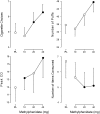Methylphenidate increases choice of cigarettes over money
- PMID: 21059817
- PMCID: PMC3001957
- DOI: 10.1093/ntr/ntq198
Methylphenidate increases choice of cigarettes over money
Abstract
Introduction: Stimulants increase cigarette smoking in the naturalistic environment and laboratory. The effects of methylphenidate on a 9-trial, discrete cigarette versus money ($0.25) choice task were tested to elucidate the mechanisms underlying stimulant-induced increases in smoking.
Methods: Eleven participants who reported smoking 10-20 cigarettes/day completed the study. Four doses of methylphenidate (0, 10, 20, and 40 mg) were administered across 5 experimental sessions, with placebo administered twice. One hour following medication administration and at 30-min intervals thereafter, participants chose between smoking a cigarette and receiving US$0.25. The primary behavioral outcome measure was number of cigarette choices.
Results: Methylphenidate increased the number of cigarette choices over money. Puffs per session and carbon monoxide levels increased significantly and caloric intake decreased significantly following methylphenidate administration relative to placebo.
Conclusions: The results of this study suggest that methylphenidate increases the relative reinforcing efficacy of cigarette smoking. Stimulant use may thus be an important consideration for individuals attempting to quit smoking.
Figures

Similar articles
-
Methylphenidate increases cigarette smoking in participants with ADHD.Psychopharmacology (Berl). 2011 Nov;218(2):381-90. doi: 10.1007/s00213-011-2328-y. Epub 2011 May 18. Psychopharmacology (Berl). 2011. PMID: 21590284 Free PMC article. Clinical Trial.
-
Methylphenidate increases cigarette smoking.Psychopharmacology (Berl). 2005 Oct;181(4):781-9. doi: 10.1007/s00213-005-0021-8. Epub 2005 Sep 29. Psychopharmacology (Berl). 2005. PMID: 15983792 Clinical Trial.
-
A pharmacological analysis of stimulant-induced increases in smoking.Psychopharmacology (Berl). 2007 Aug;193(3):305-13. doi: 10.1007/s00213-007-0786-z. Epub 2007 Apr 20. Psychopharmacology (Berl). 2007. PMID: 17447052 Clinical Trial.
-
Effects of methylphenidate on impulsive choice in adult humans.Psychopharmacology (Berl). 2003 Dec;170(4):390-8. doi: 10.1007/s00213-003-1547-2. Epub 2003 Sep 10. Psychopharmacology (Berl). 2003. PMID: 13680085 Clinical Trial.
-
Methylphenidate: its pharmacology and uses.Mayo Clin Proc. 2000 Jul;75(7):711-21. doi: 10.4065/75.7.711. Mayo Clin Proc. 2000. PMID: 10907387 Review.
Cited by
-
The co-use of nicotine and prescription psychostimulants: A review of their behavioral and neuropharmacological interactions.Drug Alcohol Depend. 2023 Jul 1;248:109906. doi: 10.1016/j.drugalcdep.2023.109906. Epub 2023 May 4. Drug Alcohol Depend. 2023. PMID: 37216808 Free PMC article. Review.
-
Smoking behavior characteristics of non-selected smokers with childhood attention-deficit/hyperactivity disorder (AD/HD) history: a systematic review and meta-analysis.Eur Arch Psychiatry Clin Neurosci. 2014 Aug;264(5):379-89. doi: 10.1007/s00406-014-0497-5. Epub 2014 Mar 12. Eur Arch Psychiatry Clin Neurosci. 2014. PMID: 24619241 Free PMC article.
-
More than Smoke and Patches: The Quest for Pharmacotherapies to Treat Tobacco Use Disorder.Pharmacol Rev. 2020 Apr;72(2):527-557. doi: 10.1124/pr.119.018028. Pharmacol Rev. 2020. PMID: 32205338 Free PMC article. Review.
-
Methylphenidate does not influence smoking-reinforced responding or attentional performance in adult smokers with and without attention deficit hyperactivity disorder (ADHD).Exp Clin Psychopharmacol. 2013 Oct;21(5):375-84. doi: 10.1037/a0033851. Exp Clin Psychopharmacol. 2013. PMID: 24099358 Free PMC article. Clinical Trial.
-
Adolescent mental health as a risk factor for adolescent smoking onset.Adolesc Health Med Ther. 2011 Feb 27;2:27-35. doi: 10.2147/AHMT.S11573. eCollection 2011. Adolesc Health Med Ther. 2011. PMID: 24600273 Free PMC article. Review.
References
-
- Adhikari B, Kahende J, Malarcher A, Pechacek T, Tong V. Smoking-attributable mortality, years of potential life lost and productivity losses—United States, 2000–2004. Morbidity and Mortality Weekly Report. 2008;57:1226–1228. - PubMed
-
- Cousins M, Stamat H, de Wit H. Acute doses of d-amphetamine and bupropion increase cigarette smoking. Psychopharmacology. 2001;157:243–253. doi:10.1007/s002130100802. - PubMed
-
- Darredeau C, Barrett SP, Jardin B, Pihl RO. Patterns and predictors of medication compliance, diversion, and misuse in adult prescribed methylphenidate users. Human Psychopharmacology: Clinical and Experimental. 2007;22:529–536. doi:10.1002/hup.883. - PubMed
-
- Henningfield JE, Griffiths RR. Cigarette smoking and subjective response: Effects of d-amphetamine. Clinical Pharmacology and Therapeutics. 1981;30:497–505. doi:10.1038/clpt.1981.194. - PubMed
Publication types
MeSH terms
Substances
Grants and funding
LinkOut - more resources
Full Text Sources

